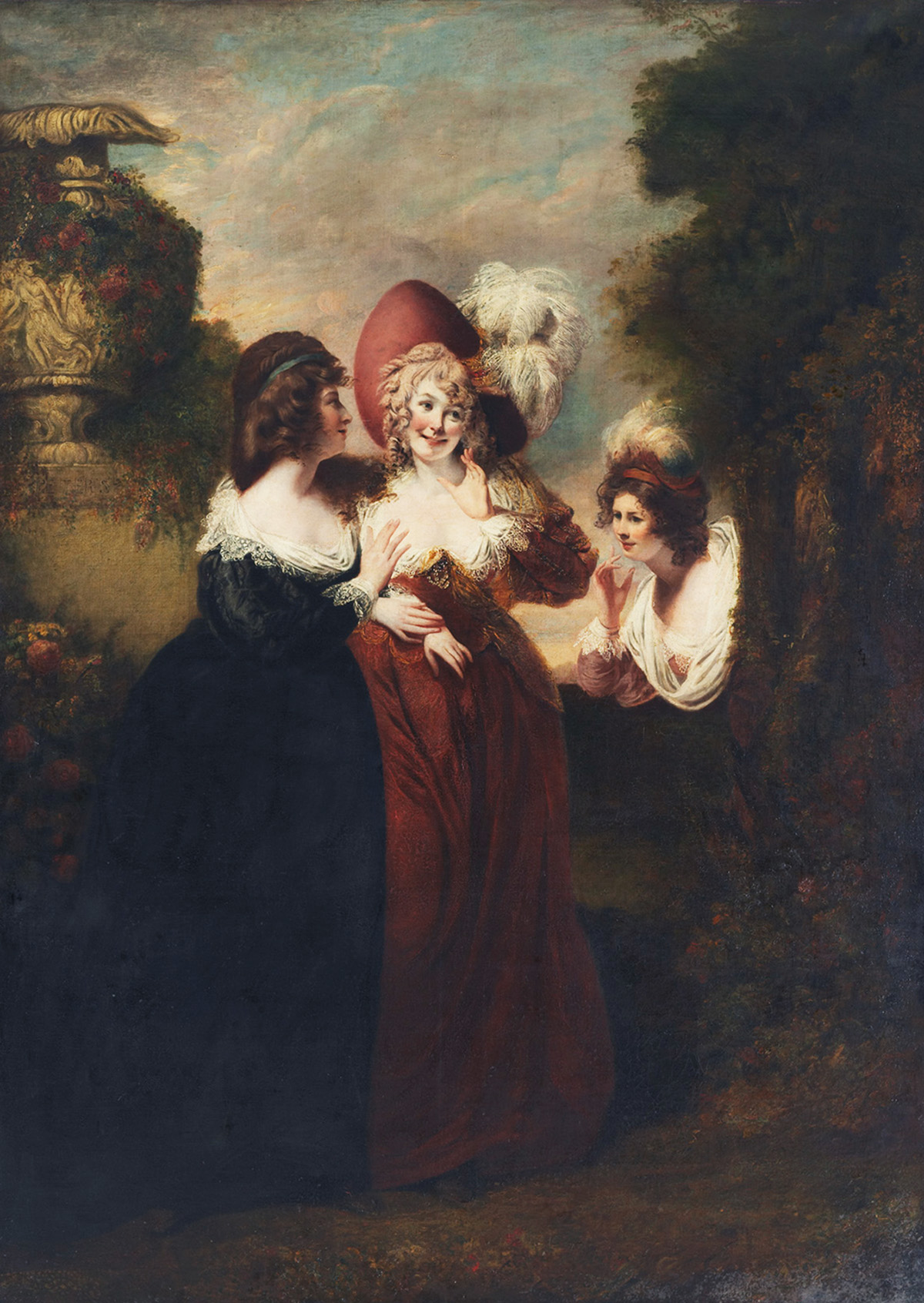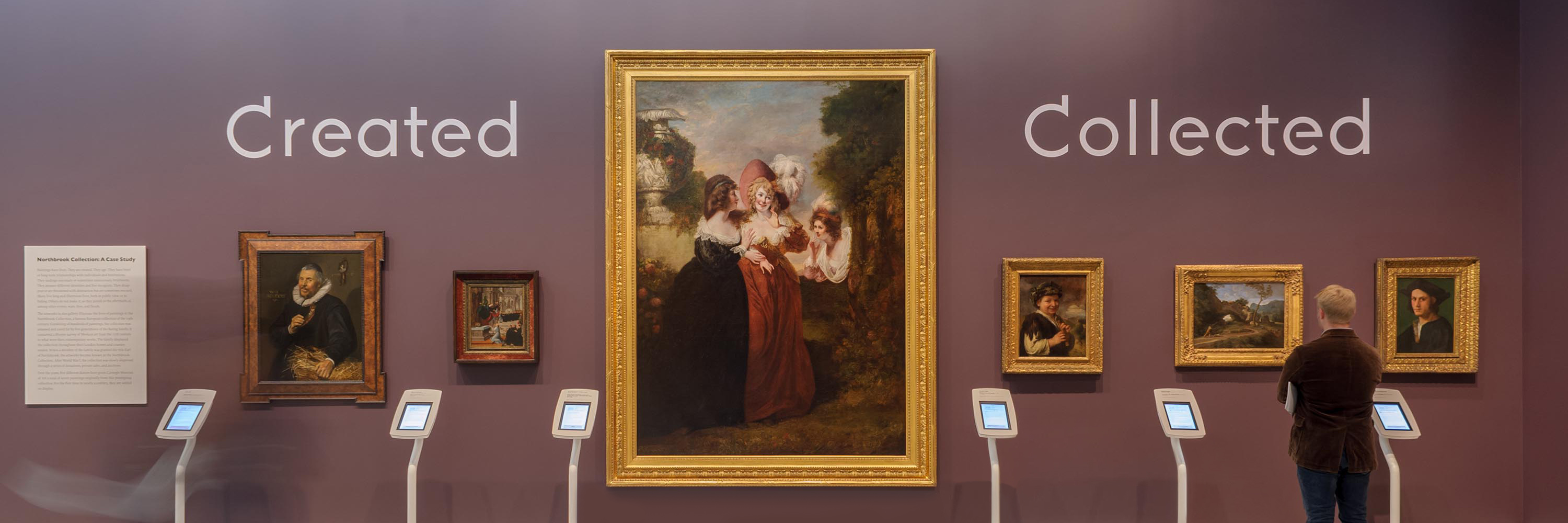Three Stories About the Painting Hero, Ursula, and Beatrice in Leonato’s Garden
Hero, Ursula, and Beatrice in Leonato’s Garden is one of seven paintings the Carnegie Museum of Art acquired that were once part of the important Northbrook Collection. The following stories trace part of this painting’s journey from artist’s studio to the walls of CMOA.

A Moment in History: London, 1789
- Current Owner
- Alderman John Boydell
- Current Location
- London, England
- Miles Traveled
- 0 miles
- Number of Owners
- One
Hero, Ursula, and Beatrice in Leonato’s Garden depicts a scene from William Shakespeare’s great comedy of manners Much Ado about Nothing. Its plot revolves around two love affairs, one of them the comical anti-courtship of Beatrice and Benedick. Constantly arguing with each other, and sworn never to fall in love or marry, they are tricked into a romance by their friends. Here Beatrice, hiding in the bushes, is allowed to overhear a conversation between Hero and Ursula. The women have fabricated a tale about Benedick’s great love for Beatrice to induce her to fall in love with him; he falls victim to a similar plot by his male friends.
The stage revivals of Shakespeare’s plays in 18th-century London were greatly enhanced in popularity by the appearance of a series of famous, racy actresses in the various female roles. The success of these revivals inspired the creation of John Boydell’s Shakespeare Gallery, a popular commercial exhibition of painted scenes from the Bard’s plays, which opened in May 1789 and for which this painting was made.
A Moment in History: Stratton Park, 1929
- Current Owner
- Francis George Baring
- Current Location
- London, England
- Miles Traveled
- 96 miles
- Number of Owners
- Seven
Of the seven paintings at CMOA, which had been part of the Northbrook Collection, Hero, Ursula, and Beatrice in Leonato’s Garden</cite> has the earliest documented entry date into that collection. It was one of two paintings purchased for Sir Francis Baring from the Boydell Shakespeare Gallery sale in May 1805. The painting remained part of the collection for well over a century, displayed at the family’s country estate, Stratton Park, in Hampshire, England. In November 1929, following the death of the 2nd Earl of Northbrook earlier that year, the painting was part of the Stratton Park Furnishings sale. It sold for £567, the highest price obtained at the sale, and nearly ten times the purchase price in 1805.
A Moment in History: Pittsburgh, 2003
- Current Owner
- Carnegie Museum of Art
- Current Location
- Pittsburgh, USA
- Miles Traveled
- 3914 miles
- Number of Owners
- Eleven
Our research found that Hero, Ursula, and Beatrice in Leonato’s Garden was approaching its sesquicentennial when it came to Pittsburgh in 1933. It was well over 200 years old when it was gifted to CMOA in 2003, though it had spent the previous nearly forty years as a guest at the museum. Here’s the story. After the painting left the Northbrook collection in 1929, it belonged briefly to another British collector, Arthur L. Nicholson. He sold it at an American Art Association sale in New York in May 1933, where it was purchased by Mrs. Alexander C. Speyer, a noted Pittsburgh sculptor. In the mid-1960s, the Speyer family placed the painting on loan deposit at the museum before donating it to the permanent collection in early 2003.
Digital Wall Labels
Select another painting for more details and to see the animated timeline:
- Painting Pieter Cornelisz. van der Morsch, by Frans Hals
- Vision of Saint Ildephonsus, by Andrien Ysenbrandt
- Hero, Ursula, and Beatrice in Leonato’s Garden, by Reverend Matthew William Peters
- Shepherd Boy with Recorder, by Unknown Northern Italian
- Landscape with a Natural Arch, by Gaspard Dughet
- Portrait of a Young Man, by Deminico Puligo
- Ann Franks Day (Lady Ann Fenoulhet), by Sir Joshua Reynolds

